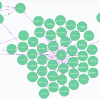Graphical models and likelihood ratios can be used by forensic scientists to compare support given by evidence to propositions put forward by competing parties during court proceedings. Such models can also be used to evaluate support for activity-level propositions, i.e. propositions that refer to the nature of activities associated with evidence and how this evidence came to be at a crime scene. Graphical methods can be used to show explicitly different scenarios that might explain the evidence in a case and to distinguish between evidence requiring evaluation by a jury and quantifiable evidence from the crime scene. Such visual representations can be helpful for forensic practitioners, the police and lawyers who may need to assess the value that different pieces of evidence make to their arguments in a case. In this paper we demonstrate for the first time how chain event graphs can be applied to a criminal case involving drug trafficking. We show how different types of evidence (i.e. expert judgement and data collected from a crime scene) can be combined using a chain event graph and show how the hierarchical model deriving from the graph can be used to evaluate the degree of support for different activity-level propositions in the case. We also develop a modification of the standard chain event graph to simplify their use in forensic applications.
翻译:暂无翻译




